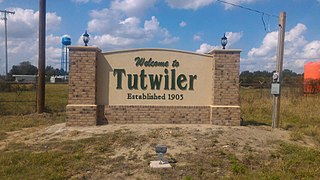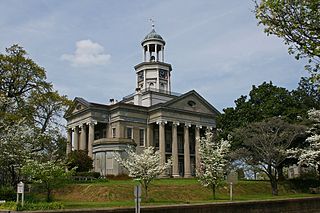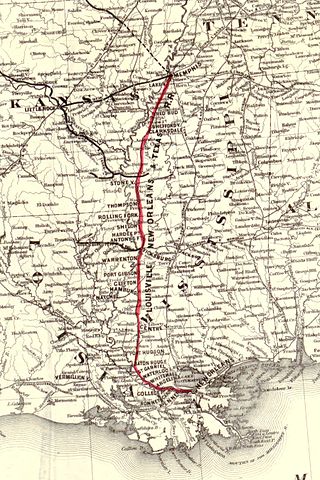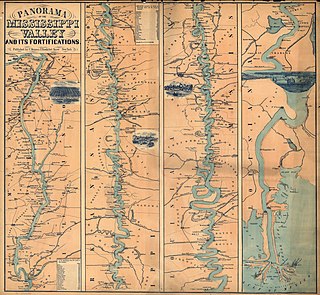
William Christopher Handy was an American composer and musician who referred to himself as the Father of the Blues. He was one of the most influential songwriters in the United States. One of many musicians who played the distinctively American blues music, Handy did not create the blues genre but was one of the first to publish music in the blues form, thereby taking the blues from a regional music style with a limited audience to a new level of popularity.

Rosedale is a city in Bolivar County, Mississippi, United States. The population was 1,873 at the 2010 census, down from 2,414 in 2000. Located in an agricultural area, the city had a stop on the Yazoo and Mississippi Valley Railroad, which carried many migrants north out of the area in the first half of the 20th century.

Clarksdale is a city in and the county seat of Coahoma County, Mississippi, United States. It is located along the Sunflower River. Clarksdale is named after John Clark, a settler who founded the city in the mid-19th century when he established a timber mill and business. Clarksdale is in the Mississippi Delta region and is an agricultural and trading center. Many African-American musicians developed the blues here, and took this original American music with them to Chicago and other northern cities during the Great Migration.

Tutwiler is a town in Tallahatchie County, Mississippi, United States. The population at the 2010 census was 3,550.

Vicksburg is a historic city in Warren County, Mississippi, United States. It is the county seat. The population was 21,573 at the 2020 census. Located on a high bluff on the east bank of the Mississippi River across from Louisiana, Vicksburg was built by French colonists in 1719. The outpost withstood an attack from the native Natchez people. It was incorporated as Vicksburg in 1825 after Methodist missionary Newitt Vick. The area that is now Vicksburg was long occupied by the Natchez Native Americans as part of their historical territory along the Mississippi. The first Europeans who settled the area were French colonists who built Fort Saint Pierre in 1719 on the high bluffs overlooking the Yazoo River at present-day Redwood. They conducted fur trading with the Natchez and others, and started plantations. During the American Civil War, it was a key Confederate river-port, and its July 1863 surrender to Ulysses S. Grant, along with the concurrent Battle of Gettysburg, marked the turning-point of the war.

Greenwood is a city in and the county seat of Leflore County, Mississippi, United States, located at the eastern edge of the Mississippi Delta region, approximately 96 miles north of the state capital, Jackson, and 130 miles south of the riverport of Memphis, Tennessee. It was a center of cotton planter culture in the 19th century.

Gustavus Cannon was an American blues musician who helped to popularize jug bands in the 1920s and 1930s. There is uncertainty about his birth year; his tombstone gives the date as 1874.

U.S. Route 61 or U.S. Highway 61 (U.S. 61) is a major United States highway that extends 1,400 miles (2,300 km) between New Orleans, Louisiana and the city of Wyoming, Minnesota. The highway generally follows the course of the Mississippi River and is designated the Great River Road for much of its route. As of 2004, the highway's northern terminus in Wyoming, Minnesota, is at an intersection with Interstate 35 (I-35). Until 1991, the highway extended north on what is now Minnesota State Highway 61 through Duluth to the Canada–U.S. border near Grand Portage, then continued to Thunder Bay, Canada, as Ontario Highway 61. Its southern terminus in New Orleans is at an intersection with U.S. Route 90. The route was an important south–north connection in the days before the interstate highway system.

The Mississippi Delta, also known as the Yazoo–Mississippi Delta, or simply the Delta, is the distinctive northwest section of the U.S. state of Mississippi that lies between the Mississippi and Yazoo rivers. The region has been called "The Most Southern Place on Earth", because of its unique racial, cultural, and economic history.

The City of New Orleans is a long-distance passenger train operated by Amtrak in the Central United States between Chicago and New Orleans. The overnight train takes about 191⁄2 hours to complete its 934-mile (1,503 km) route, making major stops in Champaign–Urbana, Carbondale, Memphis, and Jackson as well as in other small towns.

The Delta Blues Museum in Clarksdale, Mississippi, United States, is a museum dedicated to collecting, preserving, and providing public access to and awareness of the musical genre known as the blues. Along with holdings of significant blues-related memorabilia, the museum also exhibits and collects art portraying the blues tradition, including works by sculptor Floyd Shaman and photographer Birney Imes.

Memphis Central Station, referred to as Grand Central Station prior to 1944, is a passenger terminal in Memphis, Tennessee. Located along Main Street and G.E. Patterson Boulevard in Downtown Memphis, it currently a service stop for Amtrak's City of New Orleans route, arriving in late evening northbound and in the morning southbound. It is also served by the MATA Trolley system. The building was opened in 1914, and is located within the city's South Main Arts District. It is also an contributing property to the South Main Street Historic District of the National Register of Historic Places, as are the National Civil Rights Museum and other historic properties within the district boundaries.

Baton Rouge station is a historic train station located at 100 South River Road in downtown Baton Rouge, Louisiana. It was built for the Yazoo and Mississippi Valley Railroad which got absorbed by the Illinois Central Railroad. The station was a stop on the Y&MV main line between Memphis, Tennessee and New Orleans, Louisiana. The building now houses the Louisiana Art and Science Museum.

The Louisville, New Orleans and Texas Railway was built between 1888 and 1890 and was admitted to the Illinois Central Railroad system in 1892. It ran between Memphis, Tennessee, and New Orleans, Louisiana, through Vicksburg, Mississippi, and Baton Rouge.
A Mississippi Landmark is a building officially nominated by the Mississippi Department of Archives and History and approved by each county's chancery clerk. The Mississippi Landmark designation is the highest form of recognition bestowed on properties by the state of Mississippi, and designated properties are protected from changes that may alter the property's historic character. Currently there are 890 designated landmarks in the state. Mississippi Landmarks are spread out between eighty-one of Mississippi's eighty-two counties; only Issaquena County has no such landmarks.

The Mississippi Delta Railroad is a shortline railroad company operating from Swan Lake to Jonestown, Mississippi, a distance of 60 miles (97 km); the railroad interchanges with the Canadian National at Swan Lake. Currently the railroad is owned by Coahoma County and was a former subsidiary of Gulf and Ohio Railways shortline group. The current operator is Rock Island Rail.
Chicago Mercantile Independent Battery Light Artillery was an artillery battery that served in the Union Army during the American Civil War.
The Vicksburg, Shreveport and Pacific Railway was chartered as the Vicksburg, Shreveport, & Texas Railroad Company with an east and west division on April 28, 1853, to be a link, via a transfer boat, between Vicksburg, Mississippi, Shreveport, Louisiana, and points west.
Prince Albert McCoy was an American string band musician who played violin and had a pivotal but, until recently, unacknowledged role in the development of blues and popular music. No recordings by him exist.

The Mississippi River was an important military highway that bordered ten states, roughly equally divided between Union and Confederate loyalties.

















